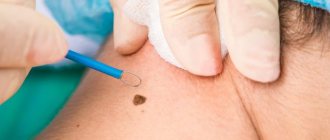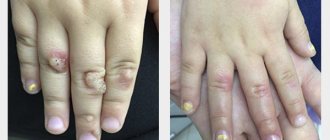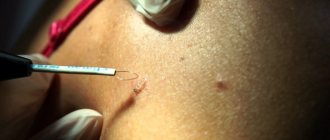Date of publication: 08.28.2020 22:42:00 Date of modification: 04.14.2021 Author: Lada Obereg
Veronika Herba - urban beauty and health center
From this article you will learn:
- Why you may need to remove a keratoma
- What types of keratomas exist?
- Why is keratoma dangerous and why is it necessary to remove it?
- Removal of keratoma: main methods and their features
- Rehabilitation period after keratoma removal
Keratoma removal is a surgical intervention based on the use of one of the possible destructive treatment methods. Thanks to this operation, you can completely get rid of this specific formation on the skin of a dark brown or brown color, similar to a freckle.
When a keratoma first appears, it can be very small, but after a while it grows to 1–2 centimeters. Most often this is a single formation, but sometimes small groups can form. Patients do not feel any pain, but the feeling of discomfort forces people to seek help from a doctor.
Why you may need to remove a keratoma
Keratoma is a benign neoplasm on the skin, which consists of epidermal cells. It can be either small in size (a few millimeters) or quite large (up to 5 centimeters in diameter). Keratomas are usually slightly darker than the natural color of the skin or have a brown color. Over time, the surface of the keratoma becomes rough and rough.
The neoplasm is formed from human skin cells, which gradually layer on top of each other. At the same time, the upper layer becomes horny, skin scales die and fall off under mechanical stress, for example, during washing, but the deeper layers of the dermis also become keratinized. The process of continuous cell renewal leads to the fact that the keratoma does not disappear on its own, but can cause inconvenience for a long time.
Under normal conditions, the number of dead and new cells on human skin is balanced in such a way that the epidermis has time to renew itself in time and maintain a healthy state. If this balance is disturbed and the cells become keratinized at a faster rate than they are renewed, then various growths appear on the skin, including benign ones, such as keratomas.
Benign neoplasms on the skin are not dangerous to human health, since they consist of normal, unchanged cells. However, there is a fairly high probability that these formations will degenerate into malignant ones when exposed to a number of negative factors. These include, for example, excessive sun exposure or contact with toxic chemicals.
Keratomas can occur on any area of the skin. They can be single or form groups. Most often, keratomas are located on the neck, shoulders and arms. Less common on the lower body.
Currently, the reasons for the appearance of these formations on the skin are not fully understood. Nevertheless, scientists have proven that prolonged exposure to the sun and visiting a solarium promotes the growth of keratomas.
What types of keratomas exist?
There are several types of keratomas:
- seborrheic;
- age;
- senile;
- horny;
- solar;
- follicular.
Seborrheic keratoma is an extremely unpleasant skin disease. In appearance, these are small spots of yellow or brown color, but they tend to increase in size over time, become covered with cracks, and become rough. There may be a feeling of itching and burning, as well as bleeding and pain in the affected areas of the epithelium.
Senile keratomas form in older people. They are yellowish or brown in color and can reach 5–6 centimeters in diameter. Age-related keratomas are usually raised and felt above the skin. They may have an uneven surface, as if covered with pits, resembling a thimble. Most often, these skin growths form on the neck, face and arms.
Senile keratoma usually appears in people over 30 years of age. It becomes covered with a grayish crust. A benign neoplasm is subject to constant inflammatory processes and bleeding.
Recommended articles on the topic:
- Ultrasonic facial peeling is a pleasant and beneficial procedure for your skin
- Redermalization of the skin: all the pros and cons
- Almond peeling for the face: features of the procedure
Horny keratoma gets its name because it looks like an animal horn. Typically, this variant of the skin disease is an advanced form of age-related or seborrheic type keratoma.
Solar keratoma affects those who like to abuse tanning or visiting a solarium. It forms on areas of the skin that are most exposed to ultraviolet radiation - the face, arms, shoulders, chest. Keratoma is colored gray, yellow or brown.
Follicular keratoma appears on areas of the skin covered with hair (head, face). It looks like a nodule, colored gray and reaching 1.5 centimeters in diameter. This is the rarest type of keratoma.
What are skin tags?
the skin growth is acrochordon, which means a small benign tumor that appears on the skin in folds or in places of excessive friction (neck-collar area, groin).
Figure 3. Skin tags are benign skin tumors
In Russian literature, such skin growths are also called soft fibromas. The size of skin growths can vary widely from barely noticeable protrusions to hanging skin formations of 2-5 mm or more.
Why is keratoma dangerous and why is it necessary to remove it?
Keratoma itself does not pose a threat to human life and health. However, due to the fact that over time it is increasingly exposed to negative factors, such as mechanical damage and exposure to ultraviolet radiation, this benign neoplasm can degenerate into a malignant tumor.
Sometimes a keratoma can cause significant discomfort to a person. Itching, burning sensation, inflammation, bleeding, pain - all these are alarming signs. The appearance of these symptoms may indicate that the process of degeneration of the keratoma into a malignant neoplasm has begun.
If you notice new moles, spots on your skin, or strange growths, be sure to visit a dermatologist-oncologist who can conduct research and determine whether the formations on the skin are malignant. Next, it is important to undergo regular medical examinations to prevent the occurrence of cancerous tumors.
Also, in a medical institution, you may be offered to remove keratomas on the face and other parts of the body and get rid of the need to regularly see a doctor.
Removal of keratoma: main methods and their features
Keratoma removal is a surgical operation, a destructive method of treating skin diseases, which involves excision of excess epithelial formations. Keratoma is a special formation of the epidermis that is dark brown or yellowish in color, resembling a pigment spot. The size of a keratoma can range from small (a few millimeters) to large (several centimeters). Usually this is a single spot, but sometimes they can form small groups. Keratomas are not dangerous to health and usually do not cause significant discomfort to a person. They can go away on their own when the keratinized cells completely exfoliate and fall off.
Doctors say that keratoma is not hereditary, but is the result of the influence of negative environmental factors. The main one is exposure to ultraviolet radiation during uncontrolled exposure to the sun, due to which skin cells die and become keratinized, forming keratomas. Over time, they grow and change color to dark or yellow.
Keratoma is not at all life-threatening and is not a cause for concern. However, it can cause significant physical and aesthetic discomfort to a person. In addition, there is a possibility that when exposed to certain negative factors, it will degenerate into a malignant tumor.
The procedure for removing keratoma has multiple positive reviews. This is the best way to get rid of complexes and prevent the development of serious health problems. It is not recommended to remove keratoma at home. An operation to get rid of a skin tumor must be carried out in a medical clinic only by certified specialists in a way that is most suitable for the patient due to the individual characteristics of his body.
Removal of skin tumors
Skin tumors must be removed. For different reasons. Aesthetic discomfort, potential health hazard, risk of damage and malignancy are only part of the indications for coagulation procedures for epithelial growths.
We provide professional, painless and inexpensive removal of moles, papillomas, warts and other benign skin growths. Our doctors work on unique laser equipment, which has no analogues not only in Russia, but also abroad. Depending on the category of complexity of the tumor, we use both the traditional CO2 laser method and combine carbon dioxide and erbium (cold) lasers. This approach guarantees 100% results both when removing the body of a small mole and when performing more complex operations.
Destructive methods for removing keratomas
Compared to removing keratoma with ointments, surgical excision is the fastest and most effective way to eliminate cosmetic skin imperfections. Modern medicine offers several destructive types of treatment for dermatological formations. Methods for removing keratomas are:
- treatment of growths with radio waves;
- removal of keratoma with liquid nitrogen;
- cauterization of tumors with electric current (electrocoagulation);
- laser burning of epithelial defects;
- surgical removal of growths.
The doctor at the clinic helps the patient choose the most effective and appropriate of the listed methods for removing skin defects.
- Radio wave removal of large keratomas
One of the most gentle ways to influence the skin is radio wave removal of keratoma. To perform the operation, a special device is required - surgitron. Narrowly directed radio waves emitted by this device affect different layers of the skin, causing evaporation of intracellular fluid and destruction of the keratoma. Using an applicator, the doctor controls the depth of treatment of the epidermis during the procedure, which helps fight formations of different sizes. To eliminate pain during the session, local anesthesia is used.
Advantages of keratosis removal using the radio wave method:
- minimal impact on healthy skin;
- speed and high efficiency of the procedure;
- absence of complications and scars after manipulations;
- short recovery time for the epidermis;
- possibility of treating large areas of keratoma localization.
- Laser removal of keratomas
Laser correction of skin tumors is an effective method for treating diseases of the dermis, the essence of which is the effect of laser beams on altered epithelial cells and their destruction. Since the laser prevents the opening of bleeding, the risk of complications is minimal. This technology involves exposing the skin to high temperature, which blocks the development of bacteria and infection. Healthy skin is not subject to the destructive effects of the laser, so there are no scars left after the procedure. Laser keratosis removal is suitable for patients who have increased sensitivity to light or dark, tanned skin.
- Removal of keratomas with liquid nitrogen
Cryotherapy, or exposing the skin to liquid nitrogen, is another effective way to remove tumors. Using a special apparatus or a cotton pad, liquid nitrogen is applied to problem areas, which leads to instant freezing of pathologically altered epithelial cells. This technique provides high aesthetic results, since under the influence of cold, keratoma cells fall off, and healthy skin is not injured.
However, there is a possibility of relapse of the disease, since the root of the tumor is not completely removed. If the keratomas are small and there are not many of them, removal can be done in one session. Foci of accumulation of neoplasms should be treated with nitrogen over several visits to the dermatologist. At your appointment, a qualified doctor will be able to assess the extent of skin damage and prescribe the required number of procedures.
We recommend
Laser aesthetic cosmetology: the perfect technique for an ideal appearance Read more
Cryotherapy has a significant drawback. After a session to remove keratoma with liquid nitrogen, a bubble forms on the skin, which does not go away for several days. It is important not to damage this area during hygiene procedures, as this may disrupt the healing process. Puncture of the bladder may contribute to the development of wound infection. If the resulting bubble causes significant inconvenience to the patient, it is necessary to consult a doctor who will treat the wound and apply a sterile bandage.
The nitrogen therapy procedure is contraindicated for people prone to allergic reactions to exposure to low temperatures, with chronic and oncological diseases in the acute stage, and who are carriers of the herpes virus. Infectious and inflammatory processes are also a limitation.
- Electrocoagulation of keratome
Removal of keratomas using electrocoagulation is another modern and effective way to get rid of tumors on the skin. It is especially effective when dealing with fresh growths. If keratomas have appeared a long time ago, coagulation is unlikely to help. The essence of this method is the destructive effect of electric current on keratoma cells, which leads to necrosis of pathological tissues and their loss. This procedure is quite painful, so it is performed using local anesthesia. Electrocoagulation involves removing tumors without affecting healthy epithelial cells. This is especially important if there is a risk of degeneration of a benign tumor into a malignant one.
- Surgical excision of keratoma
The surgical method of excision of keratoma involves performing the procedure using a scalpel. The doctor may prescribe surgery under local anesthesia in the following cases:
- the presence of contraindications for other destructive methods of keratoma removal;
- the process of degeneration of keratoma into a malignant formation;
- large areas of skin damage;
- ineffectiveness of other methods of treating skin diseases.
The surgical method of removing keratoma has a number of disadvantages:
- long and painful postoperative recovery period;
- damage to healthy dermal tissue around the site of keratoma localization;
- risk of wound infection and bleeding;
- the need for suture material;
- scars and scars after surgery.
To speed up the process of tissue regeneration and reduce the risk of infections, the doctor prescribes antibiotics and painkillers to the patient.
Questions and answers on removing papillomas
For all answers to questions , see the FAQ section.
- Warts
- Methodology
- Equipment
- Papillomas
- Indications
- Recommendations
- Moles
- Price
- Grinding
- Pregnancy
- Age
- A tan
- Infection
- Number of procedures
- Collost
- Cosmetic seam
- Lactation
- Anesthesia
- Restrictions
- Oncology
- results
- Eyelid
- Wine stains
- Ingrown nail
- Histology
- Zhiroviki
- Molluscum contagiosum
- Face
- Calluses
- Papillomas
- Dark spots
- Stretch marks
- Scar
- Striae
- Tattoo
- Acne
- Scars
Collapse answers
— Is it possible to remove papillomas while breastfeeding?
Elena
Answered by Gaidina Tatyana Anatolyevna, cosmetologist-surgeon, candidate of medical sciences. for 14 years - Unless there are urgent indications, we do not recommend removing papillomas during breastfeeding. There are many ways to remove papillomas: electrocoagulation, liquid nitrogen, using a radio knife, laser, etc. In our centers we use CO2 surgical laser - this is the most effective and, at the same time, gentle method today. With guaranteed protection against infection due to the lack of contact of the instrument with the skin.— I have multiple papillomas. Is it possible to remove 20 papillomas at a time? What is the likelihood of new papillomas appearing after removal in the future?
Alexander
Answered by Titov Alexey Ivanovich, cosmetologist-surgeon, Ph.D. for 20 years - In one session you can remove 20-25 papillomas and even more. Of course, if you wish, the procedure can be performed under anesthesia. If we are talking about human papillomavirus infection, then the appearance of new papillomas is possible; immunologists are involved in the treatment of this disease. We only remove papillomas, but do not eliminate the cause of their occurrence.— I would like to remove a papilloma on the body, the area is about 1 square. see: Is a preliminary examination necessary? I visited an oncologist at the district clinic - he said it was an ordinary papilloma, he offered to remove it himself, I suppose with a scalpel, but he refused. How long does the procedure take? Focus on cost.
Inga
Answered by Markova Irina Vyacheslavovna, a cosmetologist-surgeon for 11 years - Laser removal of skin formations, including papillomas - the procedure is outpatient, performed under local anesthesia, the duration of removal is several minutes. Before removal, a consultation with a doctor is required, the cost of which is counted when calculating the cost of papilloma removal on the day of treatment. The removed material can be sent for histology for a fee to examine the malignancy of the formation. The cost of removal depends on the area - face or body, on the size of the papilloma in millimeters and the number of papillomas removed at the same time. Anesthesia is paid additionally.
Discount program for our clients.
A discount system is provided for our clients, allowing them to receive services from the Rednor Cosmetology Centers at discounts. Depending on the number of services received, you can receive a discount card for 5%, 10% and 15% .
How to get a discount card for Rednor Cosmetology Centers?
1. A 5% discount card can be obtained after the first visit and payment for the first service (except for consultation). Card discounts are provided on services from the next visit.
2. A 10% discount card can be obtained after a one-time payment for services costing from 10,000 rubles. A 10% discount on the card is available from your next visit.
3. A 15% discount card is provided to clients who invited their 3 or more friends to use the services of the Rednor Cosmetology Centers. This card, which gives the right to receive a 15% discount, is personalized, and upon presentation, an identification document may be required. The right to a 15% discount on a personalized card cannot be transferred to others . If you want to get a 15% discount card - read the details
Rehabilitation period after keratoma removal
Removal of keratomas by any of the above methods involves a postoperative period, which lasts differently. The longest recovery process is observed after surgery. It can range from 2 weeks to 4 months.
After removing a keratoma using any of the destructive methods, it is important to adhere to the following recommendations:
- avoid contact of water and moisture on the affected area of the skin;
- do not remove the crust on the treated area of the dermis, as this can lead to the appearance of scars, scars and infection;
- try not to touch the inflamed epithelium and not expose it to ultraviolet radiation;
- use medications prescribed by a doctor;
- do not self-medicate, do not resort to traditional medicine unless your doctor approves it.
If you follow these recommendations, the regeneration process will be quick, painless and without complications.
After the keratoma removal procedure, it is important to come to an in-person appointment with a doctor for an examination 10–12 days later. The doctor will be able to evaluate the effectiveness of the applied technique and outline a plan for further action, as well as give recommendations for skin care.
In our clinic, you can remove keratomas using liquid nitrogen, as well as any other methods at an affordable price. After consultation, specialists will select the most suitable procedure and eliminate the skin defect.
Why clients choose Veronika Herba Beauty and Health Center:
- This is a beauty center where you can take care of yourself at a reasonable cost, while your face and/or body will be treated not by an ordinary cosmetologist, but by one of the best cosmetologists in Moscow. This is a completely different, higher level of service!
- You can receive qualified help at any time convenient for you. The beauty center is open from 9:00 to 21:00, seven days a week. The main thing is to agree with your doctor in advance on the date and time of your appointment.
Sign up for a consultation with a specialist by phone +7 (495) 085-15-13
, and you will see for yourself!
Surgical removal of warts
Plantar warts are most often removed surgically. As a rule, they are a benign neoplasm, saturated with blood vessels. In its structure, such a growth usually resembles cauliflower. Sometimes it can grow into the skin, causing pain when walking and rubbing against shoes. Plantar warts most often become a source of spread of the human papillomavirus.
The surgical method is used only if conservative therapy is ineffective. First, the doctor takes a test for histology and gives a tetanus vaccination. The operation itself includes the following steps:
- Treating the sole with soapy water.
- Separation of the hyperkeratosis covering the wart in order to determine its contours.
- Skin treatment with povidone-iodine.
- Local anesthesia with mepivacaine (2%) or another drug without the use of vasoconstrictors.
- Light massage with gauze to quickly spread the anesthetic.
- A skin incision and complete excision of the pathological growth.
- Cleaning the cut area using a Jansen spoon.
- After stopping the bleeding, clean the wound with saline solution.
- Treatment of the area with povidone-iodine, followed by application of a bandage.
After the procedure, the patient should try to keep the operated limb in an elevated position. Relative rest is recommended for 48 hours after surgery. During this time, it is necessary to avoid open sources of heat and, if necessary, take painkillers.
After 48 hours, the first dressing is done, during which the dried blood is removed with a scalpel, and the wound is washed with saline solution under pressure. After this, an enzymatic ointment is applied to the treated area, which is covered with polyethylene on top. Using shoes with an orthopedic insole, the patient can already lean slightly on the operated leg.











